Body temperature can be measured in a number of ways. Traditionally, body temperature has been measured using contact thermometers that are placed on the forehead or in the mouth, ear, armpit, or rectum.
Infrared thermometers allow a person’s temperature to be taken with minimal (tympanic) or no (Non-contact infrared thermometer, thermal scanner) contact with the person.

Normal human body temperature
You can take a temperature using the mouth (oral), anus (rectal), armpit (axillary), or ear (tympanic). But the temperature readings vary depending on which one you use, and you need an accurate body temperature to determine if a fever is present.
Medical research hasn’t determined an exact correlation between oral, rectal, ear, armpit, and forehead temperature measurements. Generally, the correlation between temperature results are as follows:
- The average normal oral temperature is 98.6°F (37°C).
- A rectal temperature is 0.5°F (0.3°C) to 1°F (0.6°C) higher than an oral temperature.
- An ear (tympanic) temperature is 0.5°F (0.3°C) to 1°F (0.6°C) higher than an oral temperature.
- An armpit (axillary) temperature is usually 0.5°F (0.3°C) to 1°F (0.6°C) lower than an oral temperature.
- A Forehead (temporal) scanner is usually 0.5°F (0.3°C) to 1°F (0.6°C) lower than an oral temperature.
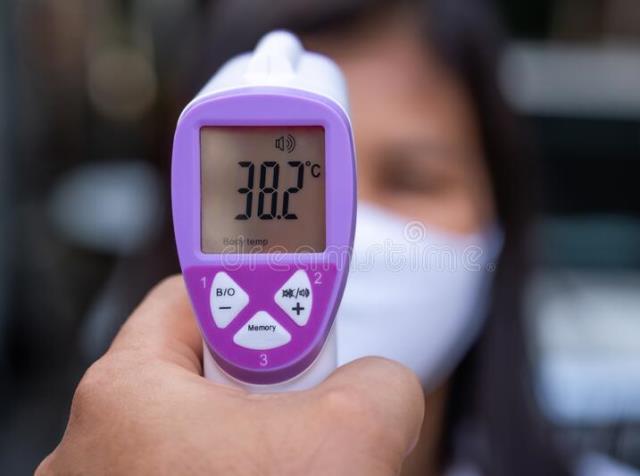
Non-contact Thermometer for body temperature
This means the temperature can be measured without the discomfort of having to sit still with a thermometer in the mouth, armpit, or rectum long enough to obtain a correct temperature reading.
The lack of contact also means the disinfection process between patients for the thermometers is minimal or unnecessary, allowing for easier and faster use when screening large numbers of people in settings like airports or border crossings.
The main types of non-contact thermometers are non-contact infrared thermometers, tympanic thermometers, and thermal scanners.
- Non-contact infrared thermometers are held three to 15 cm away from the patient and typically measure temperature on the forehead or temple.
- Tympanic thermometers measure the thermal radiation from the tympanic membrane and within the ear canal.
- Handheld thermal scanners can be used to take a person’s temperature from a greater distance than other non-contact thermometers, which may make them a good candidate for use in mass screening situations.
The optimal cut-off temperature for determining fever differs for each device. However, not everyone who has an infection or is infectious will have a fever. Additionally, fevers can be lowered by using antipyretic medications.
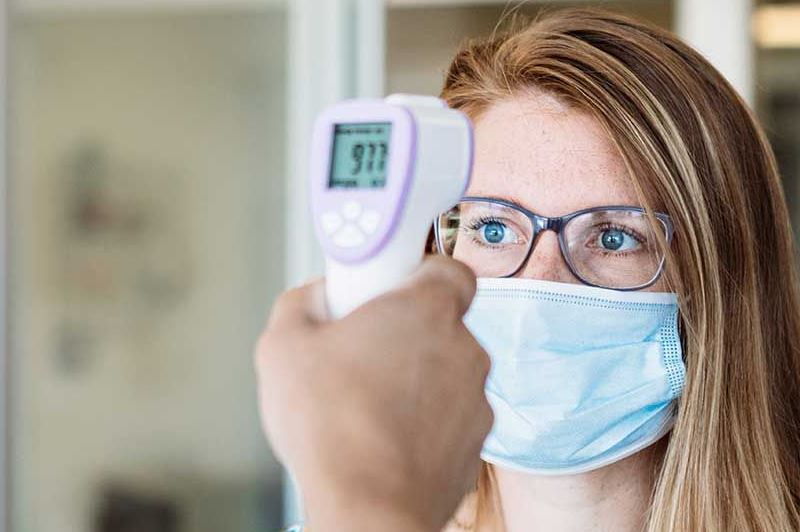
How to measure body temperature?
Temperature Taking Hints and Tips:
- Make certain the thermometer is in FOREHEAD MODE.
- Non-contact infrared thermometers measure surface temperature. Hold the device approximately 1 inch (2-3 cm) from the center of the forehead to capture just the forehead temperature and not the temperature of other surrounding objects.
- Always hold the thermometer and the forehead steady when taking a reading. Do not move the thermometer until you hear the final beep.
The device is designed to be used indoors. Users and the thermometer should be at the same ambient temperature for at least 10 minutes before taking a reading.
- The tested individual should be away from extreme temperatures for at least 10 minutes before taking a measurement. Recent exposure to hot or cold temperatures will impact your reading.
- Do not take temperatures with this thermometer near places that are very hot, such as fireplaces and stoves.
- The tested individual should not drink, eat, or be physically active before/while taking the measurement.
Remove hair, sweat, oils, cosmetics, or dirt from the forehead before taking a measurement. Wait at least 10 minutes after washing the forehead area before taking a reading. Remove hats and wait 10 minutes before taking a reading. Bangs may cause higher readings.
What are sites for measuring body temperature?
What are sites for measuring body temperature?
Temporal artery temperature changes are faster than a temperature taken rectally, orally or under the arm. A difference of 1°F (.6°C) is normal. Body temperature can change throughout the day.
Consistently low-temperature readings may be caused by a dirty instrument window. Use an alcohol wipe or a cotton swab moistened with alcohol (70% isopropyl) to clean the instrument window and housing. Gently wipe and let air dry.
DO NOT use any other cleaning liquids or immerse the thermometer in water. Wait 10 minutes after cleaning to take a temperature. See the manual for complete cleaning instructions.
Normal forehead temperature
Fast-read digital thermometers use a method called “peak hold” that is often less accurate than a digital thermometer that needs to be held in the mouth for 60 seconds or more.
- It is helpful to know each individual’s normal temperature when they are well.
- This is the best way to accurately diagnose a fever.
- To determine normal temperature, take multiple readings when healthy.
- Re-measure with a standard digital thermometer for confirmation. This thermometer displays an oral equivalent temperature reading.
- Oral readings are approximately 0.9°F (0.5 °C) lower than a rectal digital measurement.
- When comparing temperature taken with different thermometers at different sites, it is important to start with the most accurate oral temperature that can be achieved.
It is best to correlate other types of temperature taking to a baseline oral temperature taken with accurate oral thermometers, (those without the “peak hold” function).
Infrared Thermometer Body Temperature Forehead
The forehead temperature is several degrees lower than the core body temperature of 98.6 F (37 C). Forehead medical thermometers make a mathematical adjustment to show an equivalent oral temperature.
When general-purpose infrared thermometers are used to read forehead temperature, the readings are likely to be less than 98.6 F, even if there is a fever.
The normal temperature of the skin of the forehead can vary several degrees depending on your environment (indoor or outdoor), exercise, perspiration, direct heat or air conditioning, etc.
It would be normal to read an actual forehead skin surface temperature between 91 ° F and 94 ° F if you use a general-purpose infrared thermometer.
The most read
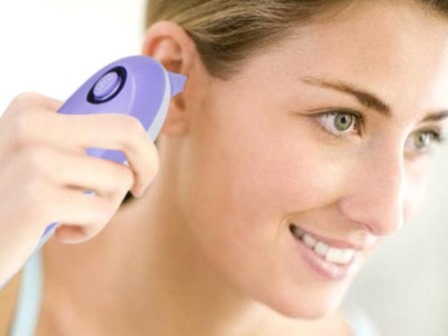
Infrared Thermometer for Humans
Infrared thermometers for humans allow users to measure body temperature quickly and non-invasively.
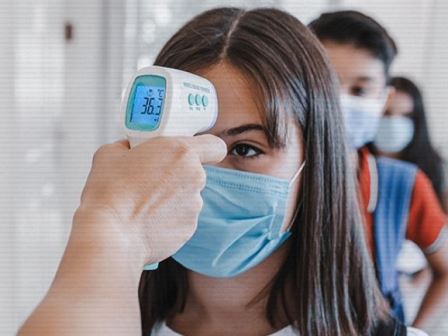
What is a Normal Forehead Temperature?
What is a “normal” human body temperature? That question is a bit more difficult to answer than you think.
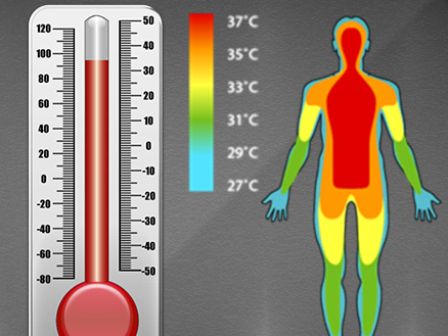
Normal Body Temperature
Your body has an internal thermostat and your goal is to keep your temperature as close to your goal as possible. What’s the normal body temperature?
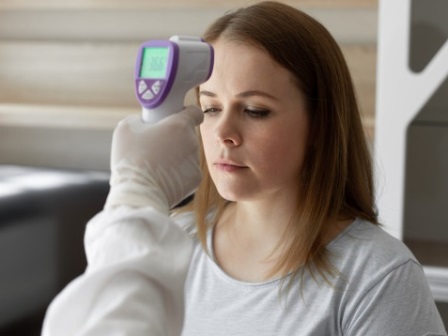
Non-contact Infrared Thermometer
Looking for the best non-contact medical thermometer
